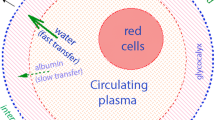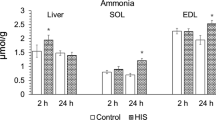Abstract
Glycerol is a naturally occurring 3-carbon alcohol in the human body. It is the structural backbone of triacylglycerol molecules, and can also be converted to a glycolytic substrate for subsequent metabolism. Serum glycerol concentrations approximate 0.05 mmol/L at rest, and can increase to 0.30 mmol/L during increased lipolysis associated with prolonged exercise or caloric restriction. When glycerol is ingested or infused at doses greater than 1.0 g/kg bodyweight, serum concentrations can increase to approximately 20 mmol/L, resulting in more than a 10 mOsmol/kg increase in serum osmolality.
Glycerol infusion and ingestion have been used in research settings for almost 60 years, with widespread clinical use between 1961 and 1980 in the treatment of cerebral oedema resulting from acute ischaemic stroke, intraocular hypertension (glaucoma), intracranial hypertension, postural syncope and improved rehydration during acute gastrointestinal disease. Since 1987, glycerol ingestion with added fluid has been used to increase total body water (glycerol hyperhydration) by up to 700ml, thereby providing benefits of improved thermoregulation and endurance during exercise or exposure to hot environments. Despite the small number of studies on glycerol hyperhydration and exercise, it appears to be an effective method of improving tolerance to exercise and other heat-related stressors.
Similar content being viewed by others
References
Elia M, Khan K, Calder G, et al. Glycerol exchange across the human forearm assessed by a combination of tracer and arteriovenous exchange techniques. Clin Sci 1993; 84 (1): 99–104
Bortz W, Paul P, Haff AC, et al. Glycerol turnover and oxidation in man. J Clin Invest 1972; 51: 1537–46
Newsholme EA, Taylor K. Glycerol kinase activities from vertebrates and invertebrates. Biochem J 1969; 112: 465–74
Frank MSB, Nahata MC, Hilty MD. Glycerol: a review of its pharmacology, pharmacokinetics, adverse reactions, and clinical use. Pharmacotherapy 1981; 1: 147–60
Lin EC. Glycerol utilization and its regulation in mammals. Annu Rev Biochem 1977; 46: 765–95
Oscai LB, Essig DA, Palmer WK. Lipase regulation of muscle triglyceride hydrolysis. J Appl Physiol 1990; 69 (5): 1571–7
Stryer L. Biochemistry. New York: W.H. Freeman and Company, 1988
Sommer S, Nau R, Wieland E, et al. Pharmacokinetics of glycerol administered orally in healthy volunteers. Arzneimittel Forschung 1993; 43 (7): 744–7
Havel RJ. Some influences of the sympathetic nervous system and insulin on mobilization of fat from adipose tissue: studies of the turnover rates of free fatty acids and glycerol. Ann N Y Acad Sci 1965; 131: 91–101
Winkler B, Steele R, Altszuler N. Relationship of glycerol uptake to plasma glycerol concentration in the normal dog. Am J Physiol 1969; 216: 191–6
Pelkonen R, Nikkila EA, Kekki M. Metabolism of glycerol in diabetes mellitus. Diabetologia 1967; 3: 1–8
Bjorntorp P, Bergman H, Varnauskas E, et al. Lipid mobilization in relation to body composition in man. Metabolism 1969; 18 (10): 840–51
Borchgrevink CF, Havel R. Transport of glycerol in human blood. Proc Soc Exp Biol Med 1963; 113: 946–9
Larsen JA. Elimination of glycerol as a measure of the hepatic blood flow in the cat. Acta Physiol Scand 1963; 57: 224–34
Tourtellotte WW, Reinglass JL, Newkirk TA. Cerebral dehydration action of glycerol. Clin Pharmacol Ther 1972; 13: 159–71
Montner P, Stark DM, Riedesel ML, et al. Pre-exercise glycerol hydration improves cycling endurance time. Int J Sports Med 1996; 17 (1): 27–33
Freund BJ, Montain SJ, Young AJ, et al. Glycerol hyperhydration: hormonal, renal, and vascular fluid responses. J Appl Physiol 1995; 79 (6): 2069–77
Gleeson M, Maughan RJ, Greenhaff PL. Comparison of the effects of pre-exercise feeding of glucose, glycerol and placebo on endurance and fuel homeostasis in man. Eur J Appl Physiol 1986; 55: 645–53
Riedesel ML, Allen DY, Peake GT, et al. Hyperhydration with glycerol solutions. J Appl Physiol 1987; 63 (6): 2262–8
Lyons TP, Riedesel ML, Meuli LE, et al. Effects of glycerolinduced hyperhydration prior to exercise in the heat on sweating and core temperature. Med Sci Sports Exerc 1990; 22 (4): 477–83
Murray R, Eddy DE, Paul GL, et al. Physiological responses to glycerol ingestion during exercise. J Appl Physiol 1991; 71 (1): 144–9
Montner P, Zou Y, Robergs RA, et al. Glycerol-enhanced hydration reduces free water clearance and increases cardiac stroke volume. J Exerc Physiol online. http://www.css.edu/users/tboone2/asep/toc.htm 1998; (in review)
Hagnevik K, Gordon E, Lins LE, et al. Glycerol-induced haemolysis with haemoglobinuria and acute renal failure: report of three cases. Lancet 1974; I: 75–7
McCurdy DK, Schneider B, Schele H. Oral glycerol: the mechanism of intraocular hypotension. Am J Ophthalmol 1966; 61: 1244–9
Wapnir RA, Sia MC, Fisher SE. Enhancement of intestinal water absorption and sodium transport by glycerol in rats. J Appl Physiol 1996; 81 (6): 2523–7
Mitchell JB, Voss KW. The influence of volume on gastric emptying and fluid balance during prolonged exercise. Med Sci Sports Exerc 1991; 23 (3): 314–9
Rottenberg DA, Hurwitz BJ, Posner JB. The effect of oral glycerol on intraventricular pressure in man. Neurology 1977; 27: 600–8
Seifert JG, Luetkemeier MJ, Schrage W, et al. The effects of glycerol ingestion in fluid compartment volumes, physiological function, and cycling performance [abstract 110]. Med Sci Sports Exerc 1995; 27 (5): S19
Terblanche SE, Fell RD, Juhlin-Dannfeldt AC, et al. Effects of glycerol feeding before and after exhausting exercise in rats. J Appl Physiol 1981; 50: 94–101
Wade AJ. The distribution and metabolism of glycerol in the rabbit. Biochem J 1981; 196: 547–56
Frei A, Cottier C, Wunderlich P, et al. Glycerol and dextran combined in the therapy of acute stroke: a placebo-controlled, double-blind trial with a planned interim analysis. Stroke 1987; 18 (2): 373–9
Gosepath K, Maurer J, Thews O, et al. Noninvasive determination of pressure relations of intracranial and intracochlear fluid spaces during the glycerol test in normal probands and patients with Menière’s disease. Laryngorhinootologie 1996; 75 (7): 384–7
Lees K. Therapeutic interventions in acute stroke. Br J Clin Pharmacol 1992; 34 (6): 486–93
Nau R, Prins FJ, Kolenda H, et al. Temporary reversal of serum to cerebrospinal fluid glycerol concentration gradient after intravenous infusion of glycerol. Eur J Clin Pharmacol 1992; 42 (2): 181–5
Wald SL, McLaurin RL. Oral glycerol for the treatment of traumatic intracranial hypertension. J Neurosurg 1982; 56: 323–31
Node Y, Nakazawa S. Clinical study of mannitol and glycerol on raised intracranial pressure and on their rebound phenomenon. Adv Neurol 1990; 52: 359–63
Costill DL, Fink WJ. Plasma volume changes following exercise and thermal dehydration. J Appl Physiol 1974; 37 (4): 521–5
Costill DL, Cote R, Fink WJ. Muscle water and electrolytes following varied levels of dehydration in man. J Appl Physiol 1976; 40: 6–11
Kozlowski S, Saltin B. Effect of sweat loss on body fluids. J Appl Physiol 1964; 19: 1119–24
Fortney SM, Wenger CB, Bove JR. Effect of acute alteration of blood volume on circulatory performance in humans. J Appl Physiol 1981; 51: 1594–600
Sawka MN, Toner MM, Francesconi RP, et al. Hypohydration and exercise: effects of heat, acclimation, gender and environment. J Appl Physiol 1983; 55: 1147–53
Hubbard RW. An introduction: the role of exercise in the etiology of exertional heat stroke. Med Sci Sports Exerc 1990; 22 (1): 2–5
Fortney SM, Wenger CB, Bove JR. Effect of blood volume on sweating rate and body fluids in exercising humans. J Appl Physiol 1981; 50: 292–8
Fortney SM, Nadel ER, Wenger CB, et al. Effect of hyperosmolarity on control of blood flow and sweating. J Appl Physiol 1984; 57: 1699–1705
Hubbard RW, Mathew WT, Horstman D, et al. Albumin-induced plasma volume expansion: diurnal and temperature effects. J Appl Physiol 1984; 56: 1361–8
Sawka MN, Hubbard RW, Francesconi RP, et al. Effects of acute plasma volume expansion on altering exercise-heat performance. Eur J Appl Physiol 1983; 51: 303–12
Kruhoffer P, Nissan OI. Handling of glycerol in the kidney. Acta Physiol Scand 1963; 59: 284–94
Below PR, Mora-Rodriguez R, Gonzalez-Alonso J, et al. Fluid and carbohydrate ingestion independently improve performance during 1 h of intense exercise. Med Sci Sports Exerc 1995; 27 (20): 200–10
Scheet TP, Webster ML, Wagoner KD, et al. Effectiveness of glycerol as a rehydrating agent [abstract]. Med Sci Sports Exerc 1995; 27 (5): S19 (abstract 109)
Koenigsberg PS, Martin KK, Hlava HR, et al. Sustained hyperhydration with glycerol ingestion. Life Sci 1995; 5 (7): 645–53
Zilversmit DB, McCandless EL. Fate of intravenously administered glycerol. Proc Soc Exper Biol Med 1957; 95: 755–7
Deichman W. Glycerol behavior in the animal organism: a review of the literature. Ind Med 1940; 9: 60–70
Fulop M, Brenner BM. Diuretic action of glycerol in dogs. Proc Soc Exp Biol Med 1967; 124: 893–7
Swanson RE, Thompson RB. Renal tubular handling of glycerol and ethylene glycol in the dog. Am J Physiol 1969; 217 (2): 553–62
Voy RO. Clinical aspects of the doping classes. In. Dirix A, Knuttgen HG, Tittel K, editors. The Olympic book of sports medicine. Boston: Blackwell Scientific Publications, 1988
Dirix A. Classes and methods. In. Dirix A, Knuttgen HG, Tittel K, editors. The Olympic book of sports medicine. Boston: Blackwell Scientific Publications, 1988
Grennari J, Kassirer JP. Osmotic diuresis. N Engl J Med 1974; 291 (14): 714–20
Author information
Authors and Affiliations
Corresponding author
Rights and permissions
About this article
Cite this article
Robergs, R.A., Griffin, S.E. Glycerol. Sports Med 26, 145–167 (1998). https://doi.org/10.2165/00007256-199826030-00002
Published:
Issue Date:
DOI: https://doi.org/10.2165/00007256-199826030-00002




